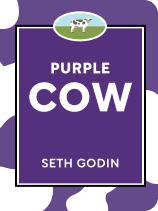

This article is an excerpt from the Shortform book guide to "Purple Cow" by Seth Godin. Shortform has the world's best summaries and analyses of books you should be reading.
Like this article? Sign up for a free trial here .
How can targeting a niche market improve your sales? What are the steps for creating a Purple Cow product in a niche market?
There’s no foolproof plan to get a Purple Cow every time. The very nature of the Cow prevents that. But if you tap into a niche market and create a remarkable product, it will attract people who are passionate about it.
Read on to learn more about creating a Purple Cow in a niche market.
Take a Different Approach
Instead of trying to make better technology for how people normally behave, see if you can encourage people to change how they use your product in a way that makes your product work better.
This is exactly how Schindler Elevator Corporation shot to the forefront of the elevator market. Elevators aren’t your average product. They’re extremely expensive and have a niche market. Elevator companies used to compete by establishing relationships with agents using dinners and golf outings, but Schindler Elevator Corporation created a Purple Cow for elevators by identifying a problem and coming up with a remarkable solution.
The problem was that elevators were inefficient. They would make many stops on their way up and down a building as people got on and off in a disorganized fashion, wasting time while people in the lobby grew more and more frustrated waiting for their own elevators. Schindler’s solution was to develop a pre-sorting system where everyone keys in their desired floors to a central control panel. A computer then figures out the most efficient way to get everyone where they’re going, and tells the passengers which elevator to take. Rather than improving the product itself, Schindler improved how people use it.
Because of their Purple Cow, Schindler is now known by practically all purchasing agents and will always have a leg up on their competitors no matter how much advertising those others do.
Tapping into a Niche Market
Something remarkable will attract the people who are passionate about it. Passionate customers are the most valuable ones; people who will not only buy your product, but will spread it to others with the same interests.
For example, the US has a subculture of people who are passionate about hot sauce, and always looking for hotter ones. It is obviously a niche market as there isn’t a huge market for sauces too spicy for most people to handle, but that hasn’t stopped dozens of such sauces from coming out and turning profits.
Compare that to mustard, which many more people use, yet few companies only make mustard. They can’t sustain themselves on mustard because people aren’t passionate about it.
This second part seems obvious, but sell people what they are in the mood to buy. Whether they’re passionate about it or not, people will buy something they need. To use that fact to your advantage, first figure out who your customers are—who’s on the left side of the idea diffusion curve in your niche market? Figure out a problem those people have, then sell them something that solves it.
For example, Altoids realized that young people who weren’t smoking wanted something to do with their hands and mouths. Altoids advertised specifically to a niche market by targeting cities with chic slogans and imagery. Then, in a second stroke of brilliance, they designed their tins to encourage sharing: The wide open top and strong smell attracts new customers on its own. The product is the marketing. Thanks to expertly targeted ads and a Purple Cow of a container, Altoids were a huge success and turned major profits.
Not a Plan, but a System
The bad news is that there’s no foolproof plan to get a Purple Cow every time. The very nature of the Cow prevents that—something created using a predictable formula would, by definition, not be a remarkable Purple Cow. However, there is a system, and it’s all about pushing boundaries. There are only two steps:
1. Ask yourself and your team where the edges of possibility are. Go back to your 5 Ps of marketing (whichever 5 you like to use), and figure out what would happen if you took each P to its extreme. Also research what your competitors are doing, and how close to each edge they are.
For example, consider Price. Perhaps you could give away your product for free. That would certainly be extreme and remarkable, though probably not good for your profits. Note that you won’t necessarily go to these edges! This is just a brainstorming exercise.
2. Next, figure out which edge will give you the results you want. What will attract people’s attention and get them to purchase your product or service? Finding the right edge to go to is how you create a remarkable product.
Could you make your product’s design so exceptional that it markets itself, like the new model of the VW Beetle? Or could you somehow improve your production and shipping processes so that you can significantly undercut your competitors’ prices, like IKEA?
This two-step process is the way people create their Purple Cows, whether they use it accidentally or on purpose.
While it’s not technically part of the system, a helpful tip is to get marketing people involved in the design process. Marketers will bring valuable perspectives to your brainstorming sessions, and will naturally be familiar with the Ps of marketing. Plus, a remarkable product will market itself (remember the VW Beetle), and a good marketer on your design team can help turn the product into its own advertisement.

———End of Preview———
Like what you just read? Read the rest of the world's best book summary and analysis of Seth Godin's "Purple Cow" at Shortform .
Here's what you'll find in our full Purple Cow summary :
- Why you have to be remarkable to succeed
- How to help your business stand out
- How to leverage a single remarkable product for all it's worth






